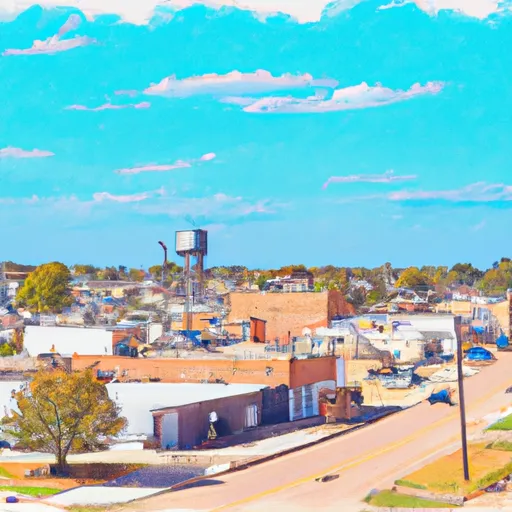-
 Snoflo Premium
Snoflo Premium
Get unlimited access to all our content
With no Ad interruptions! - Start Your Free Trial Login with existing account
Idabel
Eden Index
Climate
8.0
•
Recreation
1.1
•
Community
2.0
•
Safeguard
4.1/10

Idabel, Oklahoma is a small city located in McCurtain County in the southeastern part of the state. The climate in Idabel is typically humid subtropical, characterized by hot and humid summers and mild winters. Summers are often long and hot, with temperatures often exceeding 90°F (32°C). Winters are relatively mild, with temperatures rarely dropping below freezing.
Idabel is surrounded by beautiful natural landscapes. The city is located near the Red River, which forms part of the southern border between Oklahoma and Texas. The area is also home to numerous lakes, including Broken Bow Lake and Pine Creek Lake, offering opportunities for boating, fishing, and water sports.
Outdoor enthusiasts can enjoy the diverse wildlife and lush forests in the nearby Beavers Bend State Park. The park offers hiking trails, camping facilities, and scenic views. Additionally, the Little River National Wildlife Refuge, located south of Idabel, provides opportunities for birdwatching, wildlife observation, and photography.
Overall, Idabel, Oklahoma offers a favorable climate for outdoor activities and is surrounded by natural beauty, making it an ideal destination for those seeking recreational opportunities in a picturesque environment.
What is the Eden Index?
The Snoflo Eden Index serves as a comprehensive rating system for regions, evaluating their desirability through a holistic assessment of climate health, outdoor recreation opportunities, and natural disaster risk, acknowledging the profound impact of these factors on livability and well-being.
Climate Health Indicator (CHI): 8.0
Idabel receives approximately
1266mm of rain per year,
with humidity levels near 84%
and air temperatures averaging around
17°C.
Idabel has a plant hardyness factor of
8, meaning
plants and agriculture in this region tend to thrive here all year round.
By considering the ideal temperature range, reliable water supplies, clean air, and stable seasonal rain or snowpacks, the Climate Health Indicator (CHI) underscores the significance of a healthy climate as the foundation for quality living.
A healthy climate is paramount for ensuring a high quality of life and livability in a region, fostering both physical well-being and environmental harmony. This can be characterized by ideal temperatures, reliable access to water supplies, clean air, and consistent seasonal rain or snowpacks.
Weather Forecast
Streamflow Conditions
Red-Little
Area Rivers
Red-Little
Snowpack Depths
Red-Little
Reservoir Storage Capacity
Red-Little
Groundwater Levels
Recreational Opportunity Index (ROI): 1.1
The Recreational Opportunity Index (ROI) recognizes the value of outdoor recreational options, such as parks, hiking trails, camping sites, and fishing spots, while acknowledging that climate plays a pivotal role in ensuring the comfort and consistency of these experiences.
Access to outdoor recreational opportunities, encompassing activities such as parks, hiking, camping, and fishing, is crucial for overall well-being, and the climate plays a pivotal role in enabling and enhancing these experiences, ensuring that individuals can engage in nature-based activities comfortably and consistently.
Camping Areas
| Campground | Campsites | Reservations | Toilets | Showers | Elevation |
|---|---|---|---|---|---|
| Victor Area - Lake Wister State Park | None | 506 ft | |||
| Daingerfield State Park | 52 | 402 ft | |||
| Billy Creek | 12 | 836 ft | |||
| Cedar Springs - Lake Of The Pines | None | 269 ft | |||
| Talimena State Park | None | 1,064 ft | |||
| Winding Stair | 23 | 1,961 ft | |||
| City Park Camp - Overton | 40 | 468 ft | |||
| Hochatown State Park | None | 640 ft | |||
| Lake Of The Pines | 30 | 253 ft | |||
| Beavers Bend State Park | None | 460 ft |
Nearby Fishing
Catastrophe Safeguard Index (CSI):
The Catastrophe Safeguard Index (CSI) recognizes that natural disaster risk, encompassing floods, fires, hurricanes, and tornadoes, can drastically affect safety and the overall appeal of an area.
The level of natural disaster risk in a region significantly affects safety and the overall livability, with climate change amplifying these risks by potentially increasing the frequency and intensity of events like floods, fires, hurricanes, and tornadoes, thereby posing substantial challenges to community resilience and well-being.
Community Resilience Indicator (CRI): 2.0
The Community Resilience Indicator (CRI) recognizes that education, healthcare, and socioeconomics are crucial to the well-being of a region. The CRI acknowledges the profound impact of these elements on residents' overall quality of life. By evaluating educational resources, healthcare accessibility, and economic inclusivity, the index captures the essential aspects that contribute to a thriving community, fostering resident satisfaction, equity, and social cohesion.

